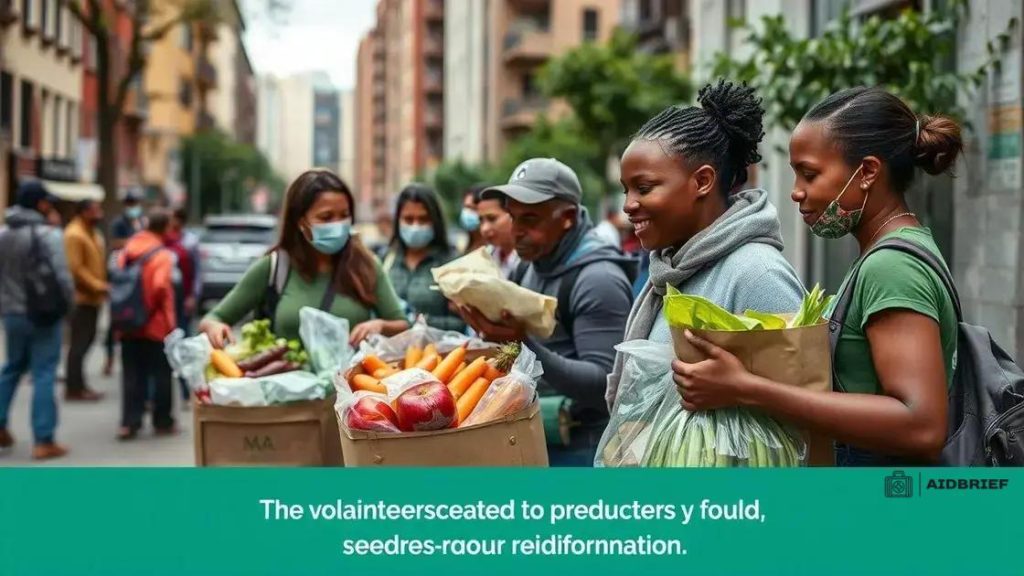Grassroots food rescue networks tackling urban waste

Grassroots food rescue networks tackle urban waste and hunger by collecting surplus food and redistributing it to those in need, actively engaging communities to reduce waste and combat food insecurity.
Grassroots food rescue networks tackling urban waste and hunger are making waves in local communities. Have you ever wondered how these initiatives transform excess food into sustenance for those in need? Let’s dive into this vital movement.
Understanding grassroots food rescue networks
Understanding grassroots food rescue networks is essential for addressing food insecurity in our communities. These networks work tirelessly to minimize waste and redistribute food to those who need it most.
What Are Grassroots Food Rescue Networks?
Grassroots food rescue networks are local organizations or initiatives aimed at collecting surplus food from various sources, such as restaurants, grocery stores, and farms, and distributing it to individuals and families facing hunger.
Benefits of Grassroots Food Rescue
These networks play a vital role in both combatting food waste and providing meals for those in need. Here are a few benefits:
- Reduces waste: By rescuing food that would otherwise be thrown away, these networks help decrease the amount of food waste in landfills.
- Supports community members: Rescued food provides nourishment to individuals facing food insecurity, creating a more equitable food system.
- Encourages local partnerships: These initiatives often foster collaboration between local businesses and community organizations.
Many grassroots networks also empower volunteers to get involved, creating a sense of community and shared responsibility for food sustainability. Through workshops and events, they educate participants on the importance of reducing food waste and addressing hunger.
One key aspect of these networks is their flexibility and adaptability. They can tailor their efforts based on the specific needs of their communities, which often leads to innovative solutions for food recovery. By utilizing local resources, each network can effectively respond to unique challenges, ensuring more people have access to nutritious meals.
Grassroots food rescue networks also inspire individuals to take action in their own lives. As communities become aware of these initiatives, they often feel motivated to reduce their own food waste at home. This ripple effect is critical in creating a culture that values food and recognizes its importance.
In summary, grassroots food rescue networks play a transformative role in our fight against hunger and waste. By understanding their contribution, we can appreciate the impact of local solutions and consider how we might support or start similar initiatives in our communities.
The impact of food waste on urban environments
The impact of food waste on urban environments is significant and multifaceted. Each year, millions of pounds of food go uneaten, contributing not only to hunger but also to environmental issues.
Environmental Consequences
When food waste is thrown away, it ends up in landfills where it decomposes. This process releases harmful gases like methane, which is a potent greenhouse gas that contributes to climate change. In urban areas, this can lead to increased air pollution, affecting the health of residents.
Effects on Local Ecosystems
Food waste also has detrimental effects on local ecosystems. The decomposition of food can lead to soil and water contamination, harming wildlife and disrupting natural habitats. As more organic waste accumulates, urban areas may face challenges in maintaining biodiversity.
- Water pollution: Decomposing food waste can leach nutrients and pathogens into nearby water sources.
- Urban heat islands: Increased waste in urban settings can elevate temperatures, creating heat islands.
- Strain on sanitation: More waste requires more resources to manage, straining local sanitation services.
Moreover, food waste can exacerbate social issues in cities. Urban areas often struggle with food insecurity, and wasted food could have been redirected to those in need. Understanding how food waste impacts our environment can help communities implement better waste management solutions.
Many cities are now recognizing the importance of addressing food waste by promoting better practices like composting and community food sharing programs. Initiatives aimed at reducing food waste help not only in alleviating hunger but also in enhancing environmental health.
By focusing on reducing food waste, cities can work toward a more sustainable future, benefiting both the environment and the community. Embracing food recovery efforts can lead to a healthier and more resilient urban ecosystem.
How grassroots networks address hunger

Grassroots networks address hunger by directly engaging with communities and providing essential resources. Their efforts are often localized, making them flexible and responsive to the unique needs of their neighborhoods.
Direct Food Distribution
One primary method that grassroots food rescue networks employ is direct food distribution. They collect surplus food from various sources and deliver it to those in need. This approach helps to ensure that perishable items do not go to waste while simultaneously feeding hungry individuals.
Community Engagement and Education
Education is another essential aspect of their efforts. Many grassroots networks host workshops and events to raise awareness about food security and the importance of reducing food waste. These initiatives empower community members to make informed choices about food and nutrition.
- Workshops: Teaching people how to cook healthy meals with rescued food.
- Food banks: Setting up local food banks where families can easily access food.
- Partnering with schools: Collaborating with schools to provide meals for students in need.
Additionally, these networks frequently collaborate with local businesses and organizations. They foster partnerships to build a stronger support system that can effectively combat hunger. By working together, they can amplify their reach and resources.
Grassroots networks also advocate for policy changes that support food recovery and hunger alleviation. They encourage local governments to create and support initiatives that make food distribution more accessible. This advocacy is crucial for changing the systemic issues behind food insecurity.
Community members often take on volunteer roles, creating a sense of purpose and ownership within the network. Whether through food sorting, distribution, or outreach, volunteers help keep the programs running and create strong community bonds. This volunteer-driven approach enhances the effectiveness of food rescue efforts.
Through these varied strategies, grassroots networks make a significant impact on hunger in urban environments. They not only provide immediate assistance but also cultivate a culture of community care and sustainability.
Success stories of local food rescue initiatives
Success stories of local food rescue initiatives highlight the positive impact these programs have on communities. These inspiring examples show how grassroots efforts can effectively combat food waste and hunger.
Community Collaboration
One remarkable success story comes from a community in California, where local restaurants partnered with food banks to create a program that redistributes unsold food. This collaboration has led to thousands of meals being provided to families in need. By working together, businesses and nonprofits can make a significant difference.
Innovative Solutions
Another initiative worth mentioning is a mobile food pantry in a Midwest city. This project uses a bus to transport fresh produce to underserved neighborhoods. The mobility of the pantry allows it to reach families who may not have access to grocery stores. Many families have benefited from this clever solution, improving their nutrition and reducing food insecurity.
- Local partnerships: Collaborations between farms and shelters ensure surplus food reaches those in need.
- Volunteer programs: Engaging community members in food collection drives increases awareness and participation.
- Success metrics: Tracking the number of meals provided helps demonstrate the impact of these initiatives.
Moreover, some initiatives focus on educational outreach, teaching families how to cook nutritious meals with rescued food. This empowers individuals to make healthier choices and reduces reliance on processed food. These programs not only address immediate hunger but also foster long-term well-being.
Many initiatives share their journeys through social media, inspiring others to start similar programs. Stories featuring the faces of volunteers and beneficiaries create a sense of community and shared purpose. When people see the positive effects of food rescue, they are more likely to get involved.
These success stories serve as a powerful reminder of what can be achieved with dedication and community effort. By highlighting their impact, grassroots food rescue initiatives motivate others to take action and contribute to a sustainable food system.
Ways to get involved in your community
Getting involved in your community can make a huge difference, especially when it comes to addressing food waste and hunger. There are several ways you can contribute positively and help local food rescue initiatives.
Volunteer Opportunities
Many grassroots organizations rely on volunteers to help with various tasks. Whether it’s sorting food, preparing meals, or distributing food to those in need, your time can be invaluable. Volunteering not only helps those in need but also allows you to connect with others who share your passion for community service.
Participate in Food Drives
Organizing or participating in local food drives can have a big impact. Food drives collect excess food and donate it to food banks or community kitchens. You can start a food drive at your school, workplace, or local community center. This is a great way to get others involved and raise awareness about food insecurity.
- Host a community meal: Bring neighbors together by hosting a meal where everyone can share and enjoy food.
- Share your skills: Offer workshops where you teach cooking skills or meals to families using rescued food.
- Donate money: Many organizations rely on donations to cover operational costs. Financial contributions help them continue their work.
Advocacy is also essential. Use your voice to promote policies that support food recovery and help those facing hunger. Educating others about the importance of reducing food waste can inspire more people to get involved.
Joining social media campaigns or community boards can further spread awareness. Share information about local food rescue initiatives or upcoming events to engage others and encourage them to participate.
Another great way to get involved is by partnering with local businesses. Encourage restaurants, supermarkets, and farms to donate surplus food. Many businesses are open to partnerships that allow them to reduce waste and support their communities.
By taking these steps, you can actively participate in making your community stronger and healthier. Your involvement can help reduce food waste and ensure that no one goes hungry.
In summary, grassroots food rescue networks play a crucial role in combating hunger and reducing food waste. By actively engaging with their communities, these initiatives not only provide essential resources to those in need but also inspire others to get involved. Through volunteering, food drives, and education, everyone can contribute to a healthier, more sustainable future. Let’s work together to ensure that no one goes hungry and that our resources are utilized wisely.
FAQ – Frequently Asked Questions about Grassroots Food Rescue Networks
What are grassroots food rescue networks?
Grassroots food rescue networks are local initiatives that collect surplus food and distribute it to those in need, helping to reduce waste and combat hunger.
How can I get involved with food rescue initiatives?
You can volunteer, organize food drives, host community meals, and advocate for policies that support food recovery in your area.
What is the impact of food waste on communities?
Food waste contributes to hunger, environmental issues, and pollution, affecting the quality of life in urban areas and draining community resources.
Why is education important in food rescue efforts?
Education raises awareness about food security and waste, empowering individuals to make informed choices and encouraging community involvement in solutions.





